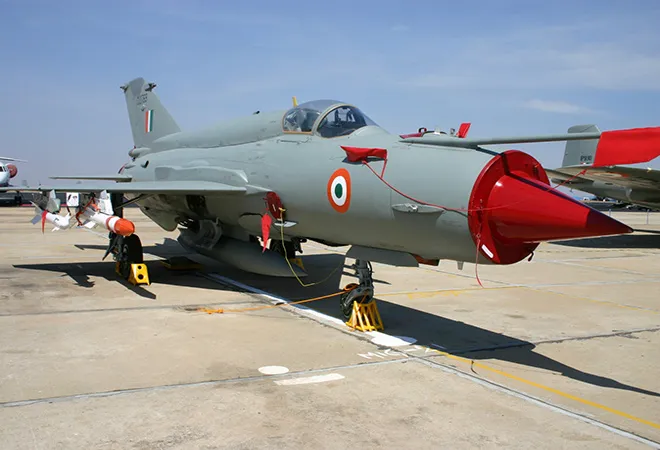
By mid-1962, twelve supersonic F-104 Starfighters had been delivered to Pakistan, and it became a matter of political urgency for New Delhi to "match" and counter the acquisition of these aircraft. The Indian desire to acquire supersonic fighter planes capable of Mach 1.5 or 2 speeds to counterbalance Pakistan's F-104s grew within the government and the nation. The media at the time began reporting on the possible purchase of two squadrons of Mig-21s.
In July 1962, a top-ranking Air Force team departed for Britain to asses a supersonic jet fighter that the British were seemingly willing to offer to India, as an alternative to the MiG-21. The plane to be evaluated was the English Electric (BAC) Lightning. However, consistent with the policy of the time and if one were circumspect, India’s current policy, reports indicate the Indian government was said to have instructed the mission led by Air Vice Marshal Harjinder Singh to convince the British of Indian interest in manufacturing fighters than in purchasing foreign-built planes. This is to say, New Delhi would be willing to acquire the Lightning for her stopgap requirements from the British if it would result in the manufacture of the aircraft in India.
Long story short, by mid-April 1963, the Indian government chose Nasik as the location of the MIG airframe factory and Koraput as the site of the MiG engine plant. At a time when India faced a severe shortage of hard currency, the Soviets allowed it to buy military hardware on extremely favourable terms and production continued till 1985 with over 900 airframes being acquired in total.
The muddled state of Indian thinking about air defence was well illustrated in mid-1962 which bafflingly continues to this day, when the government sought to buy a small number of planes, seemingly to fill immediate operational gaps, without much thought for its lack of a ground control system, adequate airfields, or radar installations. History repeated itself in 2016 when the government went in for a truncated Dassualt Rafale purchase.
For all its criticisms and accident prone operational history with the IAF, the Mig-21 remains a potent adversary for anyone who would overlook it. These jets are smaller, faster, and generally more manoeuvrable with small turning radiuses than their larger counterparts. Moreover, the MiG is notoriously hard to visually detect unless they were giving off contrails (vapour trails) and have a low radar visibility.
In 1996 the government cleared an upgrade proposal for 125 MiG-21 Bis (Bison) aircraft with an option to upgrade 50 more aircraft with major airframe, weapons, and avionics overhauls as well as some indigenously developed components. This included the incorporation of a helmet mounted cueing system combined with high-off-boresight R-73 Archer air-to-air missiles. A combination that makes the Indian Mig-21 a formidable adversary close in against a much more modern aircraft. In 2004, during the Cope India exercises the upgraded MiG-21 made for a deadly adversary in close combat for the U.S. F-15s. Fast forward to 2019, the same combination resulted in the IAF’s reported F-16 kill in the aftermath of the Balakot airstrike.
However effective the MIG maybe in niche and ideal scenarios of close air-combat in the 21st century, there now exists an urgency in replacing the legacy fleet comprising of the MiG-21 and MiG-27. The impending capability shortfall has led the IAF to push the government to acquire 4.5 Generation fighters at tremendous cost to the exchequer. The IAF’s acquisition of the Rafale and induction of the indigenously-built Tejas will take time to translate into any tangible operational capability. The Tejas continues to face developmental, induction, and build quality issues, with Hindustan Aeronautics far from achieving its delivery targets for the aircraft.
The push for the acquisition of 4.5 generation fighter aircraft to replace legacy platforms like the MiG-21 & 27 comes at a time military budget can ill afford an airframe for airframe replacement.
With this in mind, it seems intuitive that India must consider a broader range of options better suited for its combat requirements and fleet standardisation. One potential option is acquiring an additional mix of technologically up-to-date Su-30 MKI and accelerating the development of the indigenous Tejas with requisite enablers such as air-air refuelling capabilities and Airborne Early Warning and Control Systems (AEW&C), although there are certainly other options as well.
Piecemeal acquisition of 36 Rafales and possibly another similar performing aircraft like the F-16 or the Saab Gripen go against the standardisation of the IAF fleet. Reducing the number of aircraft types by acquiring only one type, as opposed to two or more, will improve affordability by reducing operating, integration, and training costs. The IAFs success (even if not by design) in exploiting the operational capacity of an aircraft like the MiG-21 lay in its acquisition in numbers and variants. Something for the government and the IAF to draw upon as they plan to recapitalise Indian air combat capability in a post MiG-21 era.
The views expressed above belong to the author(s). ORF research and analyses now available on Telegram! Click here to access our curated content — blogs, longforms and interviews.




 PREV
PREV


